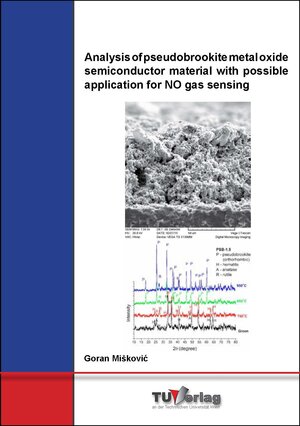
×
![Buchcover ISBN 9783903024458]()
Analysis of pseudobrookite metal oxide semiconductor material with possible application for NO gas sensing
von Goran MiškovićThis thesis deals with the preparation and application of pseudobrookite (Fe2TiO5) metal oxide semiconductor (MOS) as gas sensor to monitor hazardous gases. One of the major drawbacks of gas sensors based on the MOS materials is the relatively high working temperature above 250 ◦C. In order to achieve those high temperatures, heating elements have to be implemented, which lead to a high power consumption of the sensor. Additionally, this leads towards a more complex sensor design raising the production costs. The goal of this thesis was to synthesize, analyze and characterize pseudobrookite (PSB) metal oxide gas sensitive material and to investigate its sensitivity to nitrogen oxide (NO) gas at temperatures below 300 ◦C. In Chapter 1 a comprehensive overview of the most prominent air pollutants is given, together with the respective legalregulations. Chapter 2 gives an overview of selected, representative gas sensing methods, focusing on MOS materials. Comprehensive analyses, including the sensing mechanism and influencing factors, are studied and presented. Chapter 3 is concerned with the production and analysis of bulk and thick film PSB. The PSB material is prepared from a mixture of nanoparticles of hematite (Fe2O3) and anatase (TiO2) in two different molar ratios. To produce bulk PSB the powder is pressed into tablets and sintered at varying sintering temperatures. X-ray Powder Diffraction (XRD) analysis is used to evaluate the resulting material with respect to the formation of orthorhombic and monoclinic PSB and the transformation of the TiO2 phases (anatase into rutile).
Scanning Electron Microscopy (SEM) and Energy-dispersive X-ray Spectroscopy (EDS) of the bulk material show the effect of sintering parameters on grain size, porosity, and homogeneity. Thick film pastes are composed from the nanopowder mixtures by adding butyl cellulose as organic vehicle and a small amount of lead boron silicone oxide glass frit. This paste is screen printed on alumina substrate and sintered in a hybrid conveyor furnace with different parameters. The resulting material is characterized using XRD, SEM, and EDS. Impedance measurements on the produced samples are presented in Chapter 4. The temperature dependence of the resistance is used to estimate the band gap energies and the activation energies for the differently processed materials. Additionally a dependence on the DC–voltage was determined. Finally the sensitivity of the resistance towards a NO gas concentration was examined. The results show a reasonable sensitivity of the PSB material at temperatures below 300 ◦C. A concentration of 5% NO diluted in synthetic air could be sensed at an operating temperature of 150 ◦C.
Scanning Electron Microscopy (SEM) and Energy-dispersive X-ray Spectroscopy (EDS) of the bulk material show the effect of sintering parameters on grain size, porosity, and homogeneity. Thick film pastes are composed from the nanopowder mixtures by adding butyl cellulose as organic vehicle and a small amount of lead boron silicone oxide glass frit. This paste is screen printed on alumina substrate and sintered in a hybrid conveyor furnace with different parameters. The resulting material is characterized using XRD, SEM, and EDS. Impedance measurements on the produced samples are presented in Chapter 4. The temperature dependence of the resistance is used to estimate the band gap energies and the activation energies for the differently processed materials. Additionally a dependence on the DC–voltage was determined. Finally the sensitivity of the resistance towards a NO gas concentration was examined. The results show a reasonable sensitivity of the PSB material at temperatures below 300 ◦C. A concentration of 5% NO diluted in synthetic air could be sensed at an operating temperature of 150 ◦C.


